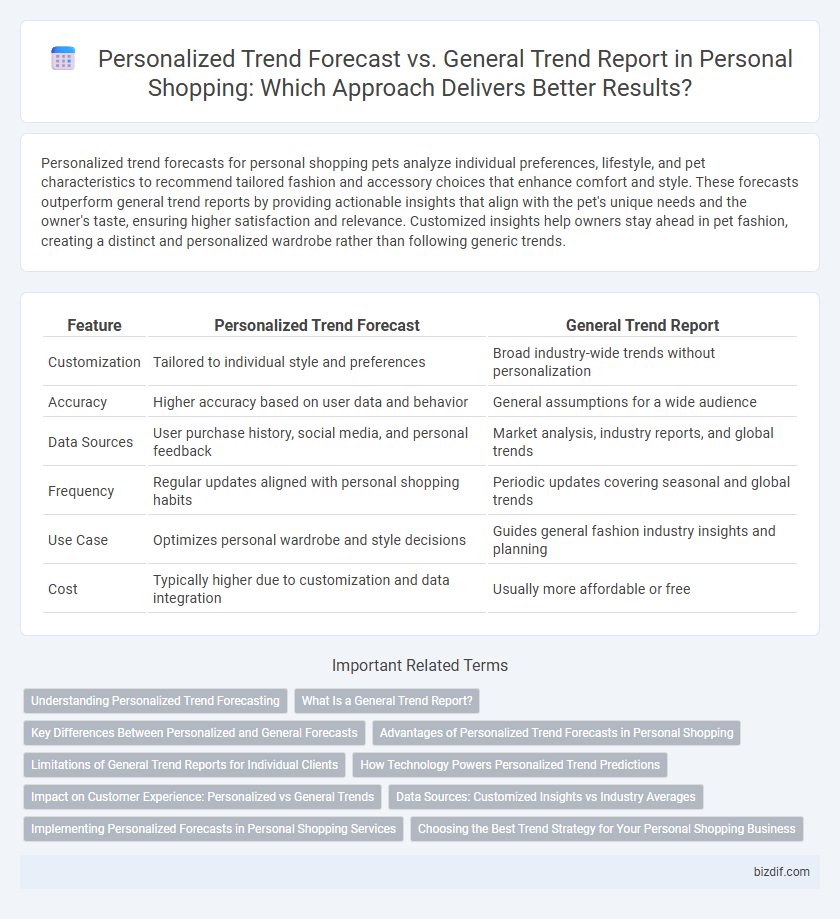Personalized trend forecasts for personal shopping pets analyze individual preferences, lifestyle, and pet characteristics to recommend tailored fashion and accessory choices that enhance comfort and style. These forecasts outperform general trend reports by providing actionable insights that align with the pet's unique needs and the owner's taste, ensuring higher satisfaction and relevance. Customized insights help owners stay ahead in pet fashion, creating a distinct and personalized wardrobe rather than following generic trends.
Table of Comparison
| Feature | Personalized Trend Forecast | General Trend Report |
|---|---|---|
| Customization | Tailored to individual style and preferences | Broad industry-wide trends without personalization |
| Accuracy | Higher accuracy based on user data and behavior | General assumptions for a wide audience |
| Data Sources | User purchase history, social media, and personal feedback | Market analysis, industry reports, and global trends |
| Frequency | Regular updates aligned with personal shopping habits | Periodic updates covering seasonal and global trends |
| Use Case | Optimizes personal wardrobe and style decisions | Guides general fashion industry insights and planning |
| Cost | Typically higher due to customization and data integration | Usually more affordable or free |
Understanding Personalized Trend Forecasting
Personalized trend forecasting analyzes individual preferences, purchase history, and lifestyle data to deliver tailored style predictions, unlike general trend reports that provide broad, mass-market insights. This approach enables personal shoppers to recommend relevant clothing and accessories that align with a client's unique fashion profile, enhancing satisfaction and engagement. Leveraging algorithms and AI, personalized forecasts anticipate emerging trends specific to the individual, creating a competitive advantage in personal shopping services.
What Is a General Trend Report?
A general trend report provides a broad overview of upcoming fashion movements based on mass market data and seasonal forecasts, aiming to inform retailers and designers about popular styles and colors. It compiles insights from industry-wide sources but lacks customization for individual consumer preferences or specific demographic nuances. While useful for understanding macro-level trends, it does not account for personal tastes or unique lifestyle factors critical for personalized shopping experiences.
Key Differences Between Personalized and General Forecasts
Personalized trend forecasts analyze individual preferences, purchase history, and lifestyle data to deliver tailored style recommendations, unlike general trend reports that provide broad industry-wide fashion insights. These customized forecasts predict trends that align with a consumer's unique taste and needs, enhancing shopping efficiency and satisfaction. In contrast, general trend reports cater to mass audiences by highlighting popular styles and market movements without considering personal variables.
Advantages of Personalized Trend Forecasts in Personal Shopping
Personalized trend forecasts leverage individual style preferences, purchase history, and lifestyle data to deliver tailored fashion recommendations, enhancing the personal shopping experience with relevant and timely insights. These customized forecasts improve the accuracy of style predictions, helping shoppers invest in pieces that align with their unique identity and long-term wardrobe goals. By contrast, general trend reports offer broad insights that may overlook personal nuances, limiting their effectiveness in guiding specific buying decisions.
Limitations of General Trend Reports for Individual Clients
General trend reports often provide broad market insights that lack specificity for individual clients' unique style preferences and lifestyle needs. These reports fail to account for personal measurements, color profiles, and body shapes, leading to less relevant fashion recommendations. Personalized trend forecasts use detailed client data to deliver customized styling advice, enhancing satisfaction and wardrobe coherence.
How Technology Powers Personalized Trend Predictions
Technology powers personalized trend predictions by utilizing artificial intelligence and machine learning algorithms to analyze individual consumer data, including purchase history, social media activity, and style preferences. Unlike general trend reports that provide broad insights based on mass market behavior, personalized forecasts deliver tailored recommendations that align with an individual's unique fashion profile and evolving tastes. Advanced data analytics and real-time monitoring enable personal shoppers to anticipate and suggest trends with greater accuracy and relevance.
Impact on Customer Experience: Personalized vs General Trends
Personalized trend forecasts enhance customer experience by delivering tailored style recommendations that align with individual preferences, boosting satisfaction and engagement. General trend reports offer broad insights but often lack relevance to unique tastes, which can lead to a less impactful shopping journey. Customized forecasting enables more precise product selections, increasing loyalty and driving higher conversion rates in personal shopping.
Data Sources: Customized Insights vs Industry Averages
Personalized trend forecasts leverage data sources such as customer purchase history, social media behavior, and real-time feedback to generate customized insights tailored to individual preferences. In contrast, general trend reports rely on industry averages, broad market analysis, and aggregated sales data, providing a one-size-fits-all overview. Utilizing personalized data sources enables more accurate predictions and client-specific recommendations compared to generalized industry benchmarks.
Implementing Personalized Forecasts in Personal Shopping Services
Implementing personalized trend forecasts in personal shopping services enhances client satisfaction by tailoring recommendations to individual preferences, lifestyle, and past purchasing behavior. Unlike general trend reports, personalized forecasts leverage data analytics and AI to predict unique style developments, ensuring customers receive relevant and timely fashion advice. This targeted approach not only boosts engagement but also increases conversion rates and brand loyalty in the competitive retail market.
Choosing the Best Trend Strategy for Your Personal Shopping Business
Personalized trend forecasts leverage data analytics and customer preferences to deliver tailored insights that align closely with individual client styles and purchasing behaviors. General trend reports provide broad market overviews but often lack the specificity needed to drive targeted inventory decisions and maximize client satisfaction. Selecting a personalized trend forecast over a general report enhances the ability to anticipate unique consumer demands, optimize stock relevance, and increase sales conversion in a personal shopping business.
Personalized trend forecast vs General trend report Infographic

 bizdif.com
bizdif.com